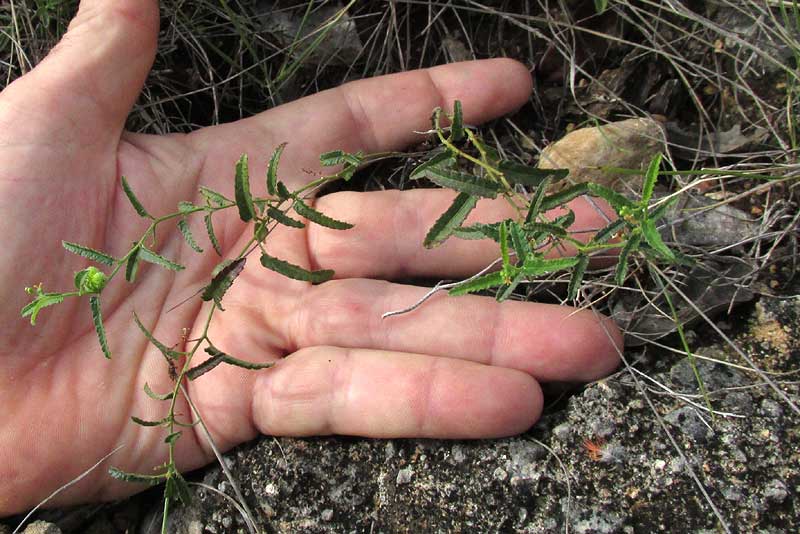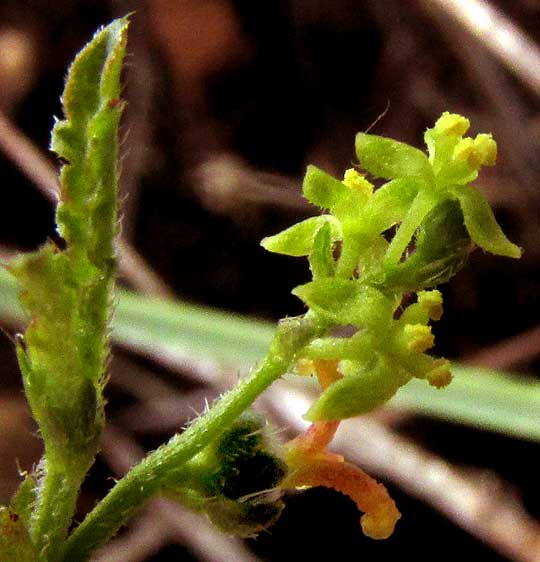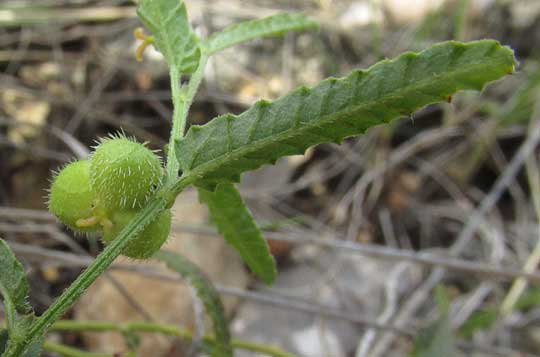Excerpts from Jim Conrad's
Naturalist Newsletter

from the September 28, 2014 Newsletter issued from the Frio Canyon Nature Education Center in the valley of the Dry Frio River in northern Uvalde County, southwestern Texas, on the southern border of the Edwards Plateau; elevation ~1750m (~5750 ft); N29.62°, W99.86°; USA
NOSEBURN
In each of the last four or so Newsletters we've looked at spindly, not-very-spectacular members of the Spurge Family, the Euphorbiaceae, mostly growing in thin, very dry soil atop limestone. This week we have another one, a whole new genus, and it also turned up in thin soil atop limestone, at the edge of a roadcut. This spate of such plants is mostly explained by the fact that this time last year I was distracted by more commonly occurring and more attention-getting plants. I just overlooked these homely little beings. Above, you can see the one found this week, with its narrow leaves conspicuously low-toothed along their margins.
At the above picture's far left you can see the Spurge Family's telltale field marks: A three-lobed, greenish fruit separated from some stamen-bearing male flowers barely visible clustering at the branch's very tip. The Spurge Family produces such unisexual flowers, sometimes with both sexes on the same plant, but sometimes on separate plants, and this one has them on the same plant. A close-up of a cluster of male flowers at a rachis tip, with a female flower just below them, with its yellow-orange, widely spreading, three-branched stigma, is shown below:

A shot of a more developed ovary, or immature fruit, appears below:

Among key features distinguishing the genus of our Spurge Family member are these:
These field marks lead us to the genus Tragia, members of which often are known as noseburns, apparently because if somehow the stinging hairs get into your nose, they're bound to burn. Eleven noseburn species are listed for Texas, of which six might be found in our area. Ours is the most commonly occurring one, sometimes called the Branched Noseburn, TRAGIA RAMOSA. It's native to the southwestern and south-central US and northern Mexico, where it grows in scrub, woodland, and other desert and plateau habitats.
Our plants aren't as heavily invested with longer, stinging hairs as those in pictures on the Internet, but hairiness often varies between populations, and our plants' consistently very narrow leaves and other traits make it convincingly Tragia ramosa.
The Navaho called our plant c'os be'yi'c'ol, which translates to "vein-spurter," a name applied to several unrelated plants with slender stems and leaves used for stopping bleeding. In southern Nuevo León, a state in northeastern Mexico, Branched Noseburn and Leatherstem (Jatropha dioica) have been boiled together to make a wash for treating hair loss.